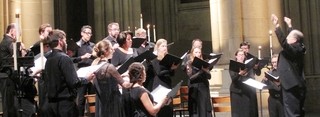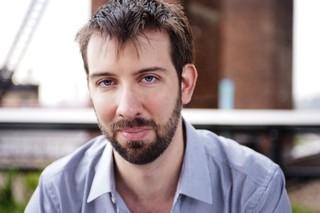|
Back
Finland’s Heavens New York
Cathedral of St. John the Divine
11/15/2016 -
“Great Music in a Great Space”:
Einojuhani Rautavaara: Vigilia
Halley Gilbert (Soprano), Helen Karloski (Mezzo-soprano), Marc Day (Tenor), Malcolm Merriweather (Baritone), Matt Boehler (Bass)
The Cathedral Choir of St. John the Divine, Kent Tritle (Conductor)

K. Tritle and Cathedral Choir of St. John the Divine (© Isadora Wilkenfeld)
First, an example of theological esoteric trivia. The people of Finland have their own religion!!
I’m not talking of Lapp shamanism either. The Finnish Orthodox Church has their own ceremonies, litany, liturgy–and after the abbreviated “complete” Vigilia (“All-Night Vigil in Memory of St. John the Baptist”) by the late Einojuhani Rautavaara (the original is three hours long, this one only 65-odd minutes), their own service, which is an emotional, colorful one.
The words, written as a Mass for John the Baptist, are of course very close to the Russian Orthodox church. Yet while Rautavaara’s music has some stylistic similarities with the Russian church music, one heard last night far more of the original composition by Rautavaara himself.
In a way, the a capella music–quite literally “in a chapel”, this the spacious St. John the Divine cathedral– has a kind of thrill. Not the thrill of, say, the Russian religious music of Rachmaninoff and Ipollitov-Ivanov, which is truly orthodox, which takes few liberties with the original Byzantine chants. Instead, Rautavaara’s Vigilia depends more on the singular conceptions of the Finnish composer.
The thrill here is listening to the wondrous ways he works with his chorus and soloists. Just as the composer had dozens of different personae in his long life, here he had a chance to use all which had learned.
Thus in the First Katisma (I use the religions terms, with little knowledge of their meaning), we had four of the five soloists joining in one after the other, in a kind of Romantic aria, followed by an Allelujah, that sounded positively Renaissance. For the actual killing of St. John, Rautavaara employed a chorus in a tremulous glissando, while the bass proclaimed–almost as a news-reader!–the details of the death.
In the Troparium, Rautavaara has more inspired moments. An ecstatic Amen, followed by whispers celebrating the Mother of God. And in the Sticheron of Invocation, the composer rises to his most enraptured moments. A poetry of glissandi by the chorus, with the bass in the most florid melodies from the very bottom of his range to the top.
But why go on? Those in the Cathedral last night had the choice of either being entranced by the music, without trying to figger out what the composer was doing, or being enthralled with the originality of each section.
Granted, as sung in the original Suomi (Finnish)–clear, lucid and apparently correct–it was never easy to follow exactly what was going on. One looked for familiar landmarks–an “Amen” or an “Allelujah”–but otherwise, one had to retain the musical singularity.
And that was easy with the great Kent Tritle leading the 40-voiced Cathedral Choir. Of course in the vastness of the Cathedral, Mr. Tritle had the double challenge of offering a vast sound while giving the clarity of a smaller ensemble singing in (for most of us) an exotic language. In this, he, as ever, fulfilled his task, for the Choir was crystalline in the quieter blessings and exuberant in the passages of greater dramatic fury.
The two female soloists were excellent: soprano Halley Gilbert more dramatic, mezzo Helen Karloski more delicate, more...er, religious. Both tenor Marc Day and baritone Malcolm Merriweather were equally appealing. But...

M. Boehler (© Courtesy of the Artist)
...well, it says nothing against those four soloists, but the solos here were above all (below all?) written for bass. Perhaps basso profundo, but more likely the bass of the Russian Metropolitan. Rautavaara was influenced by the Russian church, but he also confessed to the influence of Prokofiev’s music from Ivan the Terrible. And here, bass Matt Boehler showed not only the widest range, but some low notes (a low C? Or B flat?) that were clear and sometimes haunting
For this was a haunting performance indeed. Samuli Tikkaja’s program notes mention that while in America during his early 20’s Rautavaara stayed near the Cathedral, at 501 West 110th Street. Naturally, I had to pass the place, just two blocks from the concert. A large plaque commemorated its most famous musical resident, George Gershwin. May I humbly (after such a dynamic performance) suggest that the building management have a second plaque marking the residency of Einojuhani Rautavaara?
It might confuse some passers-by, yet those of us who have experienced the music of this artist, in his heaven only four months now, will appreciate this remembrance.
Harry Rolnick
|